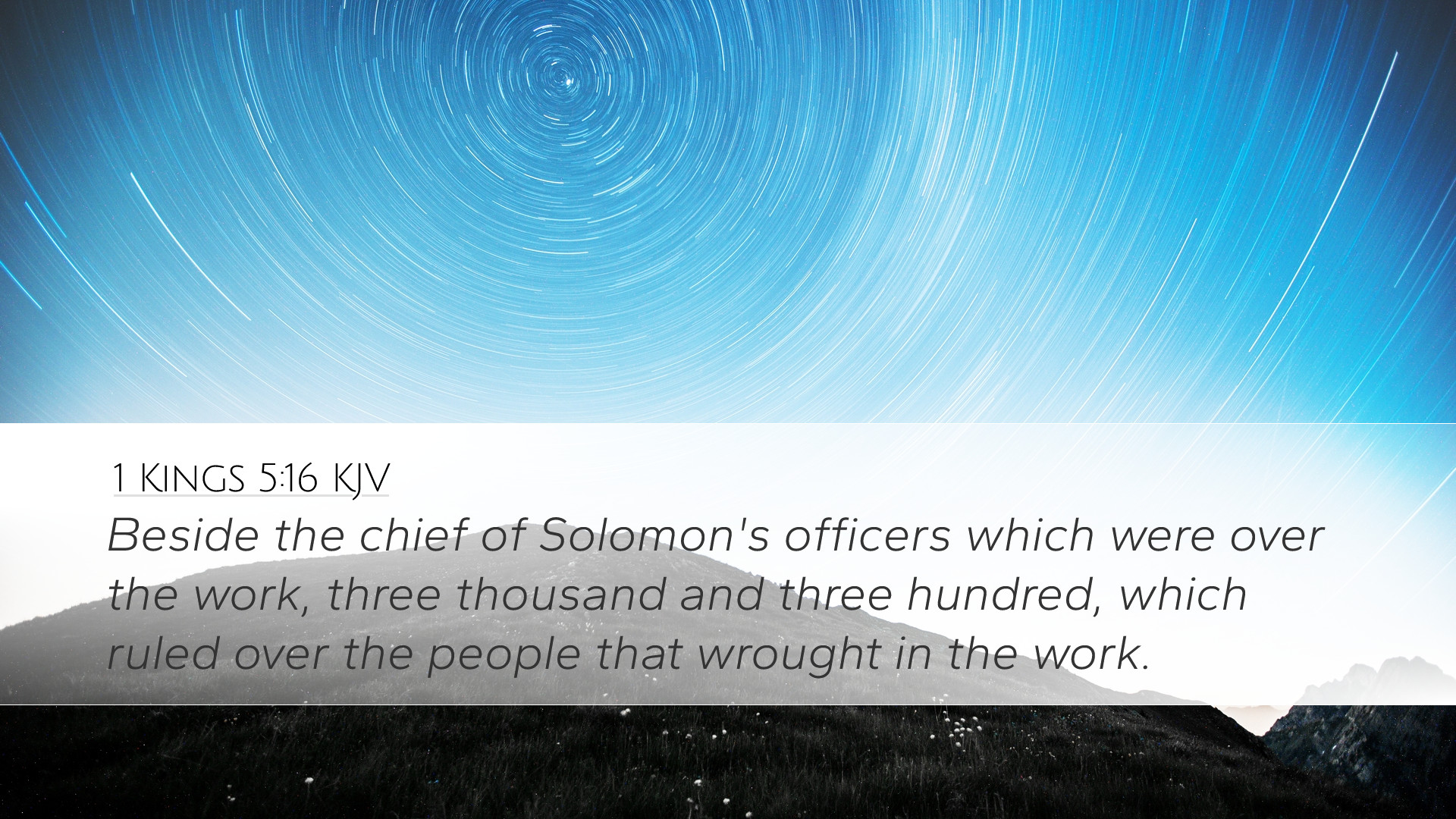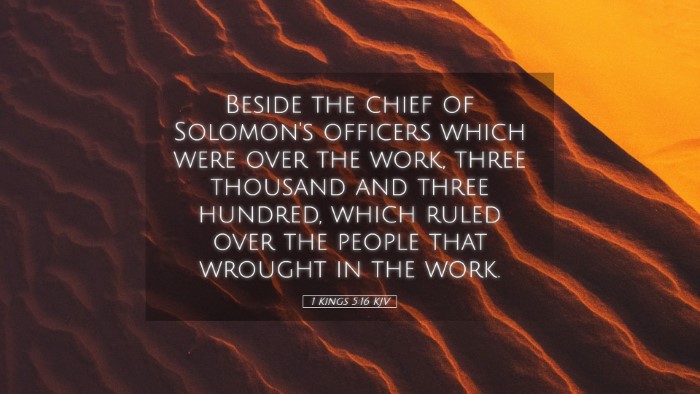Old Testament
Genesis Exodus Leviticus Numbers Deuteronomy Joshua Judges Ruth 1 Samuel 2 Samuel 1 Kings 2 Kings 1 Chronicles 2 Chronicles Ezra Nehemiah Esther Job Psalms Proverbs Ecclesiastes Song of Solomon Isaiah Jeremiah Lamentations Ezekiel Daniel Hosea Joel Amos Obadiah Jonah Micah Nahum Habakkuk Zephaniah Haggai Zechariah Malachi1 Kings 5:16
1 Kings 5:16 KJV
Beside the chief of Solomon's officers which were over the work, three thousand and three hundred, which ruled over the people that wrought in the work.
1 Kings 5:16 Bible Commentary
Commentary on 1 Kings 5:16
Verse: "And Solomon had threescore and ten thousand that bare burdens, and fourscore thousand hewers in the mountains;" (1 Kings 5:16, KJV)
Introduction
The construction of the Temple in Jerusalem marks a pivotal moment in Israel's history. 1 Kings 5:16 serves as a testament to Solomon's vast administrative capability and the magnitude of the undertaking. In analyzing this verse, insights from various public domain commentaries shed light on the implications of this labor force and the significance of Solomon's reign.
Historical Context
The reign of Solomon was characterized by peace and prosperity, a stark contrast to the preceding era of turmoil and conflict. The resources available for the temple's construction reflect both divine favor and the political stability that Solomon had cultivated. Matthew Henry notes that this verse highlights not merely the numbers involved in the labor but also signifies the grandeur of the project that Solomon was undertaking.
Personnel Involved
Solomon's labor force could be cataloged into several categories:
- Burden Bearers: The mention of 70,000 bearers of burdens indicates a significant reliance on manpower for transporting materials required for the Temple construction. This would have included stone, timber, and other supplies from distant regions.
- Hewers: The 80,000 hewers represent those who would be engaged in quarrying stone from the mountains. This labor was critical, given that the building's durability depended on high-quality stone. Adam Clarke emphasizes the expert craftsmanship likely involved in this labor.
Theological Significance
This verse encapsulates a theology of labor and service. Solomon’s reign, as represented in this numerical detail, underscores that God's work requires community labor. Albert Barnes connects this concept to the collective efforts of believers in maintaining the house of God. The commitments from the people in service reflect a unified intention towards sanctifying the space for divine habitation.
The Role of Service in Worship
The involvement of so many individuals in the construction reflects a holistic approach to worship that merges the sacred and the secular. It acknowledges that worship is not solely confined to ritualistic practices but includes all forms of service rendered to God. Matthew Henry states that such endeavor should be seen as an act of devotion where the laborers facilitate a worship space for their community.
Practical Applications
For pastors and church leaders today, this verse encourages a vision of shared responsibility within congregational life. The extensive workforce Solomon assembled serves as a model for fostering collaboration in ministry. Practical lessons can include:
- Delegation of duties: Just as Solomon organized a large workforce, leaders can recognize the need for distributing tasks among church members according to their gifts and skills.
- Emphasizing unity: Just as various groups worked together under Solomon, churches today are called to cultivate a spirit of cooperation and collaboration in various ministries.
- Validating every role: The mention of diverse roles in construction reinforces that every contribution, no matter how small, is valuable in the pursuit of a greater goal.
Conclusion
1 Kings 5:16 offers a glimpse into the organized and cooperative endeavor that was necessary for the construction of Solomon's Temple. As we reflect on this scripture, we are reminded of the importance of community effort in serving God and building spaces that reflect His glory. The insights from historical and theological perspectives help us grasp the significance of labor in worship and the shared responsibilities that bind a faith community.


